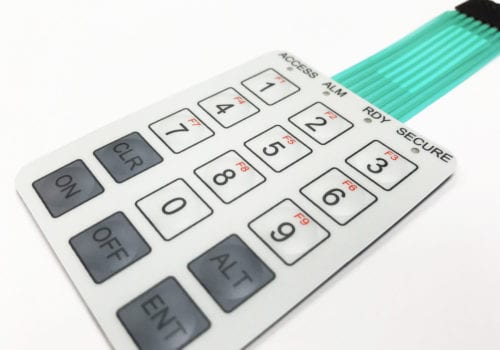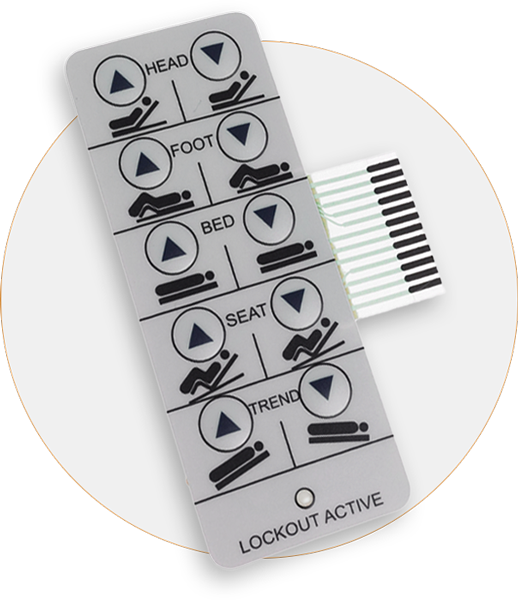Everything About Membrane Change: Comprehending Its Layout and Functionality
When you believe concerning the control interfaces in contemporary devices, membrane buttons commonly come to mind. Let's explore what sets membrane switches apart from other control systems.
What Are Membrane Buttons?

Membrane buttons can also be tailored concerning shape, size, and graphics, permitting producers to develop distinct user interfaces tailored to details products. Generally, membrane layer buttons play a considerable duty in improving customer experience across a vast range of applications.
Just How Membrane Switches Over Work
When you push a trick on a membrane button, it activates an uncomplicated yet effective system. The top layer, commonly made of versatile product, lowers onto a conductive layer underneath it. This activity bridges the gap in between conductive traces, finishing an electrical circuit. As quickly as the circuit shuts, it sends a signal to the gadget's controller, which analyzes your input.
You'll notice that the tactile comments differs based upon the button design, providing either a soft click or a more pronounced reaction. When you launch the trick, the membrane layer go back to its original setting, reopening the circuit and stopping the signal. This process takes place nearly instantaneously, ensuring a responsive individual experience.
Membrane switches are prominent because of their longevity and resistance to dust and moisture, making them perfect for different applications, from house appliances to medical devices. Understanding this operation aids you value their prevalent use.
Secret Elements of Membrane Layer Switches
Understanding the key components of membrane buttons is basic for comprehending their capability and layout. At the core, you'll locate the visuals overlay, which supplies the visual user interface for customers. Beneath that, there's a spacer layer that separates the circuit layers, ensuring that they do not make get in touch with till pushed. The circuit layer is where the magic occurs; it includes conductive traces that complete the circuit when you press the switch. Another essential component is the glue support, allowing the button to stick to surfaces firmly. Lastly, the protective layer shields against environmental factors and put on, prolonging the switch's life-span. Each element plays a considerable role in making certain reputable performance and individual communication. By comprehending these parts, you'll obtain insight right into exactly how membrane switches over run and their value in various applications.
Materials Utilized in Membrane Layer Change Layout
The performance and longevity of membrane switches over heavily depend upon the products utilized in their layout. You normally encounter polyester and polycarbonate as primary substratums as a result of their outstanding toughness and versatility. These materials withstand scrapes and chemicals, making them perfect for requiring settings.
The conductive layers commonly make use of silver or carbon, selected for their reliability and conductivity. membrane switch manufacturer. Silver gives exceptional performance, while carbon is an economical alternative. For the overlay, you might take into consideration a matte or glossy finish, depending upon your visual demands and user experience
Adhesives play a vital function as well; they bond layers safely and ensure durability. Make sure to pick adhesives that endure environmental elements like temperature and humidity. Lastly, don't ignore the significance of an excellent printing technique for graphics, as it enhances both functionality and aesthetic allure. Selecting the ideal products will certainly ensure your membrane button stands the examination of time.
Design Considerations for Membrane Switches
While developing membrane layer buttons, it's important to take into account numerous aspects that influence their capability and individual experience. Start by focusing on the format and button dimension; make specific they're instinctive and easy to browse.
Validate your design accommodates environmental elements, like wetness or temperature variations, which might influence efficiency. By meticulously considering these elements, you'll develop a membrane layer button that boosts use and satisfaction.
Applications of Membrane Layer Buttons
Membrane layer buttons are functional parts found in numerous applications, from commercial tools to customer electronic devices. You'll see their effect in makers that require durable user interfaces and in tools that profit from streamlined layouts. Recognizing these applications aids you value the capability and usefulness of membrane layer switches in daily technology.
Industrial Equipment Usage
When you're wanting to boost the performance of commercial tools, membrane switches supply a trusted remedy that combines longevity with user-friendly More Help layout. These switches are excellent for extreme settings, offering resistance to dirt, dampness, and chemicals. You'll discover them in control panels for making equipments, cooling and heating systems, and clinical devices, where precision and responsiveness are crucial. Their low profile suggests they fit seamlessly into various equipment, saving beneficial room while maintaining ease of use. With personalized graphics and backlighting options, you can produce an intuitive user interface for drivers, boosting efficiency and security. Plus, their lengthy life expectancy decreases upkeep expenses, making them a wise investment for your commercial applications. Accept membrane layer switches to improve your operations and boost overall efficiency.
Consumer Electronic Devices Integration
In the domain of consumer electronic devices, membrane buttons play a necessary function in enhancing individual communication and tool functionality. You'll locate them in gadgets like microwaves, push-button controls, and pc gaming consoles, giving a smooth means to communicate with innovation. Their sleek style permits very easy combination right into different products, making controls user-friendly and easy to use. With their ability to integrate graphics and backlighting, you can delight in a modern visual that complements the tool's overall look. Membrane layer switches likewise ensure durability and resistance to dust and dampness, prolonging the lifespan of your electronic devices. By choosing membrane layer buttons, you boost not just the functionality however also the style of your devices, making everyday interactions smooth and enjoyable.
Benefits and Drawbacks of Membrane Buttons
While membrane layer buttons provide a variety of advantages, they likewise come with some drawbacks that you should consider. One significant benefit is their compact style, making them excellent for space-constrained applications. They're also affordable, offering a sturdy solution with a low production cost. On top of that, their smooth surface area is very easy to tidy, enhancing hygiene in settings like hospitals.

Nonetheless, there are negative aspects. Membrane switches can have a shorter lifespan compared to mechanical switches, especially under hefty use. i thought about this They can likewise be much less responsive, which may influence customer responses throughout operation. Furthermore, if damaged, repairing them can be tough and typically needs total replacement. Ultimately, their level of sensitivity to severe temperature levels and environmental problems may limit their efficiency in certain setups. Stabilizing these advantages and disadvantages will aid you figure out if membrane buttons are the right fit for your project.
Often Asked Questions
The Length Of Time Do Membrane Layer Switches Over Commonly Last?
Membrane layer switches normally last in between 5 to ten years, depending upon use and ecological conditions. You'll want to review factors like wear, exposure to moisture, and temperature level see this website fluctuations to assess their longevity effectively.
Can Membrane Layer Switches Be Personalized for Particular Styles?
Yes, you can tailor membrane switches to fit details layouts (membrane switch manufacturer). You'll have the flexibility to choose colors, forms, and designs that match your job's requirements, ensuring they mix seamlessly with your total aesthetic
What Is the Expense Range for Membrane Switch Manufacturing?
The cost array for membrane layer button production generally falls between $1 and $10 each, depending on factors like design intricacy, amount, and materials. You can obtain quotes from suppliers to discover the very best choice.

Are Membrane Layer Changes Waterproof or Immune?
Membrane buttons can be created to be water-proof or immune, relying on products made use of and building techniques. If you require them for damp environments, ensure you define those requirements during the layout process.
How Do Membrane Switches Contrast to Typical Buttons?
Membrane buttons are typically thinner and extra versatile than traditional switches, supplying a smooth style. They're frequently less complicated to clean up and incorporate, but could not supply the responsive responses you're utilized to with mechanical alternatives.
Conclusion
